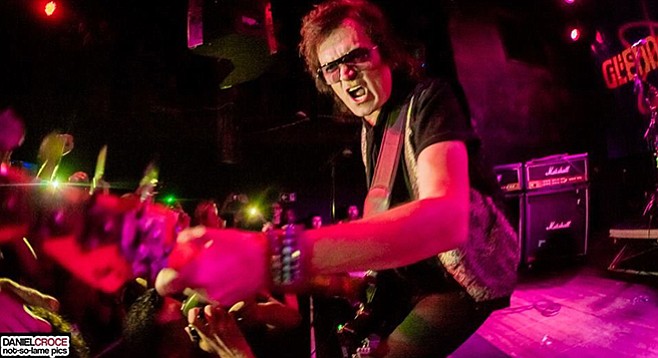 Facebook
Facebook
 X
X
 Instagram
Instagram
 TikTok
TikTok
 Youtube
Youtube

Who does Deep Purple, Stevie Wonder, and Black Sabbath’s Tony Iommi all have in common? That would be Glenn Hughes, the singing bassist from Los Angeles by way of England. One loses track of how many front men sound just like him, for Hughes’s work in the 1970s would come to be the archetype for an era of ride-or-die big-hair rock-and-rollers who would gradually come of age and replace the bluesy boogie rock that the godfathers of the art were then producing.
A twist of fate or timing, and Hughes could have gone the R&B/soul route. His voice has that roached-out texture with a revelatory range such that Stevie Wonder is said to have proclaimed Hughes his fave white singer. Instead, 1973 found him co-fronting (with David Coverdale) one of the grandest arena bands of the day, Deep Purple, a group that had gone rudderless temporarily after the departure of Ian Gillan. True enough, Deep Purple’s best work was behind them by that point, but they had at least one solid album left in them, Burn, which came out in 1974.
With Deep Purple on his résumé, Hughes’s life to follow would be a near endless road of solo work and side projects with heavy hitters such as Gary Moore and Pat Thrall and Tony Iommi. He’s been called the “Voice of Rock,” but that smacks of music-industry hyperbole. Perhaps the larger endorsement comes from his (and Deep Purple’s) induction into the Rock and Roll Hall of Fame in 2016. Finally.
But, there were also many career derailments prior to that shining night. As is somewhat typical of the era, Hughes came with heavy addiction baggage, which he finally unloaded in the ’90s. He’s in a prime-of-life place in his career now, even though it finds his arena moves confined inside the same small venues that a whole generation of indie rockers passed through with studied indifference.
JoAnne Shaw Taylor also performs.


Who does Deep Purple, Stevie Wonder, and Black Sabbath’s Tony Iommi all have in common? That would be Glenn Hughes, the singing bassist from Los Angeles by way of England. One loses track of how many front men sound just like him, for Hughes’s work in the 1970s would come to be the archetype for an era of ride-or-die big-hair rock-and-rollers who would gradually come of age and replace the bluesy boogie rock that the godfathers of the art were then producing.
A twist of fate or timing, and Hughes could have gone the R&B/soul route. His voice has that roached-out texture with a revelatory range such that Stevie Wonder is said to have proclaimed Hughes his fave white singer. Instead, 1973 found him co-fronting (with David Coverdale) one of the grandest arena bands of the day, Deep Purple, a group that had gone rudderless temporarily after the departure of Ian Gillan. True enough, Deep Purple’s best work was behind them by that point, but they had at least one solid album left in them, Burn, which came out in 1974.
With Deep Purple on his résumé, Hughes’s life to follow would be a near endless road of solo work and side projects with heavy hitters such as Gary Moore and Pat Thrall and Tony Iommi. He’s been called the “Voice of Rock,” but that smacks of music-industry hyperbole. Perhaps the larger endorsement comes from his (and Deep Purple’s) induction into the Rock and Roll Hall of Fame in 2016. Finally.
But, there were also many career derailments prior to that shining night. As is somewhat typical of the era, Hughes came with heavy addiction baggage, which he finally unloaded in the ’90s. He’s in a prime-of-life place in his career now, even though it finds his arena moves confined inside the same small venues that a whole generation of indie rockers passed through with studied indifference.
JoAnne Shaw Taylor also performs.
Comments